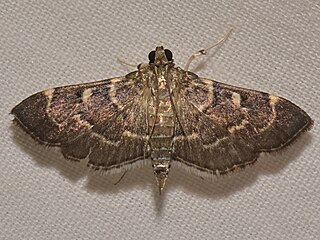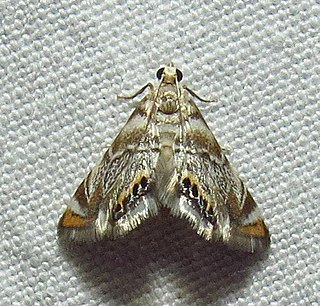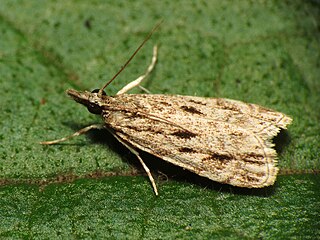
Cryptobotys is a genus of moths in the family Crambidae described by Eugene G. Munroe in 1956. It is monotypic, with its only species, Cryptobotys zoilusalis, described by Francis Walker in 1859. It is found in Cuba, Jamaica, Puerto Rico, Central America and the southern United States, where it has been recorded from Florida.
Hellula phidilealis, the cabbage budworm moth, is a moth of the family Crambidae. It is found in tropical and subtropical America. From the southern United States, north in the east to North Carolina, south through southwestern Mexico to northern South America, including several islands in the Caribbean.

Eoparargyractis irroratalis is a moth in the family Crambidae. It was described by Harrison Gray Dyar Jr. in 1917. It is found in North America, where it has been recorded from Alabama, British Columbia, Florida, Georgia, Maryland, Montana and South Carolina.

Vaxi auratellus, the curve-lined vaxi or curve-lined argyria moth, is a moth in the family Crambidae. It was described by James Brackenridge Clemens in 1860. It is found in North America, where it has been recorded from the eastern United States and south-eastern Canada from Quebec and Maine to Florida, west to Texas and north to Manitoba. It is also found in California.
Fissicrambus quadrinotellus is a moth in the family Crambidae. It was described by Zeller in 1877. It is found in Panama and North America, where it has been recorded from Florida and Texas.
Thaumatopsis pectinifer is a moth in the family Crambidae. It was described by Zeller in 1877. It is found in North America, where it has been recorded from North Dakota to Oklahoma, Texas and southern Florida, as well as Michigan and Indiana.
Trischistognatha pyrenealis is a moth in the family Crambidae. It was described by Francis Walker in 1859. It is found in Mexico, Central America, the West Indies and the southeastern United States, where it has been recorded from Georgia to Florida and from Alabama to Texas.
Dicymolomia grisea is a moth in the family Crambidae. It is found in North America, where it has been recorded from southern Texas to Florida and South Carolina.
Cangetta micralis is a moth in the family Crambidae. It is found in South America, the Caribbean and in southern Florida.

Pyrausta rubricalis, the variable reddish pyrausta moth, is a moth in the family Crambidae. It was described by Jacob Hübner in 1796. It is found in North America, where it has been recorded from Illinois to New York, south to Florida and Louisiana. It is also reported from the west coast, from southern California to Washington. The wingspan is about 15 mm and adults have been recorded on wing from March to October.
Donacaula sordidellus is a moth in the family Crambidae. It was described by Johann Leopold Theodor Friedrich Zincken in 1821. It is found in North America, where it has been recorded from Florida, Louisiana, Mississippi, Nebraska, New Jersey, New York, North Carolina, North Dakota, South Carolina and Texas.

Eudonia strigalis, the striped eudonia moth, is a moth in the family Crambidae. It was described by Harrison Gray Dyar Jr. in 1906. It is found in North America, where it has been recorded from Nova Scotia to southern Ontario and south to Florida.
Diacme mopsalis, the mopsalis diacme moth, is a moth in the family Crambidae. It was described by Francis Walker in 1859. It is found in South America, Central America, the Antilles and the southern United States, where it has been recorded from Arizona, Florida, Oklahoma and Texas.
Ercta vittata is a moth in the family Crambidae. It was described by Johan Christian Fabricius in 1794. It is found in the West Indies and South America. It has also been recorded from Costa Rica and southern Florida.
Penestola bufalis, the black penestola moth, is a moth in the family Crambidae. It was described by Achille Guenée in 1854. It is found in the US states of Texas and Florida, as well as on the Antilles. It is an accidentally introduced species on the Galápagos Islands. The habitat consists of coastal mangrove swamps and shorelines.

Phostria oajacalis is a species of moth in the family Crambidae. It was described by Francis Walker in 1866. It is found in Nicaragua, Guatemala, Costa Rica., Mexico, and southern United States.

Polygrammodes eleuata, the red-spotted sweetpotato moth or many-spotted moth, is a moth in the family Crambidae. It was described by Johan Christian Fabricius in 1777. It is found in Central and South America, on the Antilles and in the southern United States, where it has been recorded from Florida.
Samea druchachalis is a moth in the family Crambidae. It is found in Mexico and the southern United States, where it has been recorded from Florida and Texas.

Samea ecclesialis is a moth in the family Crambidae. It is found in Argentina, Brazil, Bolivia, Colombia, Ecuador, French Guiana, Panama, Costa Rica, Mexico and the United States, where it has been recorded from North Carolina to Florida, west to Texas.
Sufetula diminutalis is a snout moth in the subfamily Lathrotelinae of the family Crambidae. It was described by Francis Walker in 1866 in the genus Isopteryx from material collected in Honduras.







